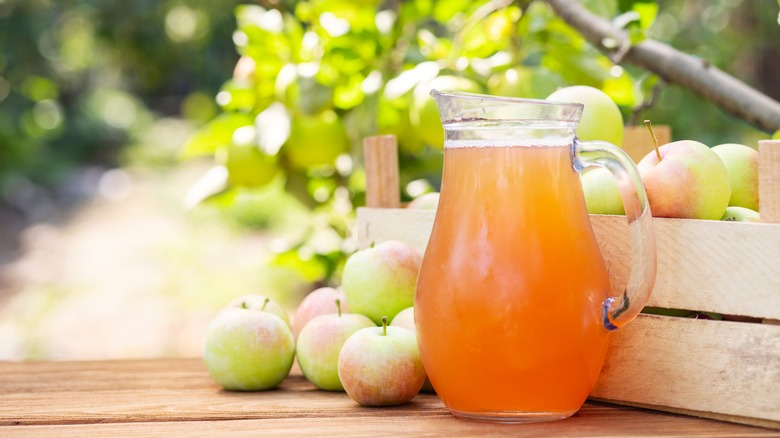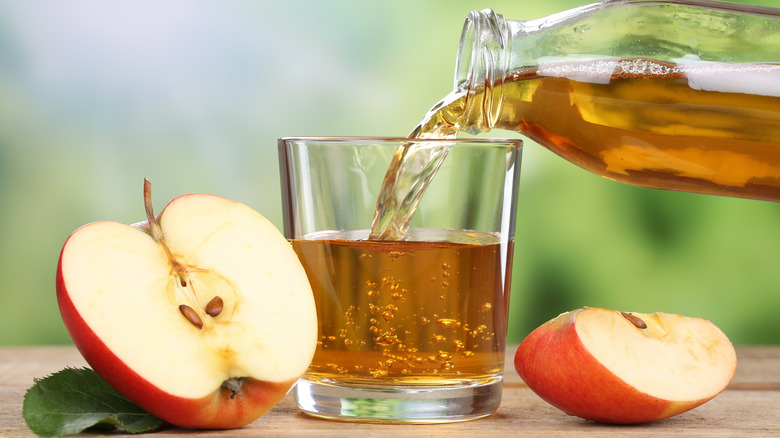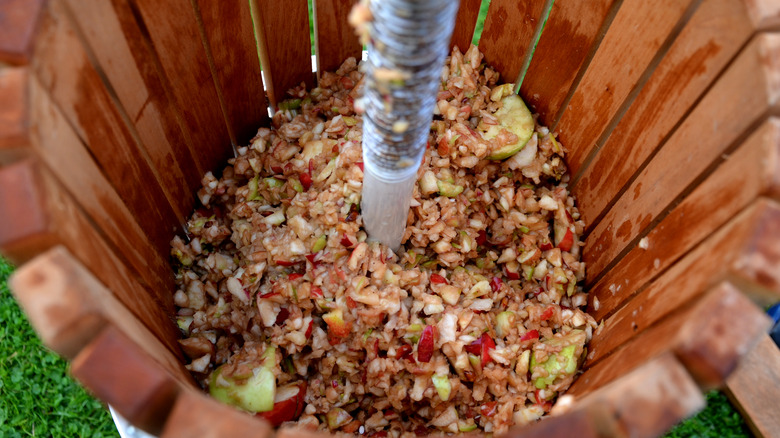The Exact Difference Between Apple Cider And Apple Juice
Farmers and consumers alike celebrate when apple season arrives, especially since apples take the top spot for total fruit consumption in America, according to the United States Department of Agriculture. That encompasses all forms of apples, including apple juice and apple cider. Those luscious liquids have the same origin, but the flavor, texture, and composition couldn't be further apart.
The core difference between apple juice and apple cider arises from the production methods employed when transforming apples in hand to juice in cups. A standard bottle of supermarket-style apple juice has likely undergone considerable processing, which includes filtering, pasteurization, concentration, and the addition of other ingredients to reconstitute flavor and ensure longevity.
Apple cider, on the other hand, is rarely processed, with little if any filtering or pasteurization, and typically with no added sweeteners. It comes straight from newly plucked apples, which get mashed and fresh-pressed into liquid. It's 100% juice, but depending on who's making the cider, it can be spiked with whole or slightly crushed natural spices for extra complexity or for holiday gatherings.
The differing approaches to making juice and cider from apples are most evident in the taste and texture, with standard apple juice being much sweeter and smoother. Cider instead harbors a robust, earthy, apple flavor with tart undertones and a more prominent mouthfeel. There's also a version of alcoholic apple cider, known as hard cider, but that's an entirely different process involving yeast and fermentation.
Concentrates in commercial apple juices
The bottled or boxed juice that's favored in kid's lunchboxes and adult cocktail recipes is almost always commercial apple juice rather than fresh-pressed cider. Clear-filtered apple juice holds visual appeal and is sweeter with a lighter flavor –– but there's a reason for that, one that involves specific processing methods and consequent additives.
Most packaged apple juice comes from what's known as juice concentrate, which is still real juice made from real apples. But the water in the juice gets removed, resulting in a slushy, potent mixture of concentrated apple essence. It's also filtered to remove apple solids, as well as pectins and fibers. The water gets added back in later, but in addition to the filtering, it's heat-treated for safety — all of which results in reduced flavor.
That's when the additives come into play, which can include sweeteners such as cane sugar, sugar substitutes, or corn syrups, as well as preservatives and either natural or artificial flavorings. These compensate for the lost flavor due to evaporation and processing — while also creating an apple juice product that's easily accessible, long-lasting, and dependable. Using concentrates is also convenient for juice purveyors, who can readily transport and store it until ready to reconstitute for making bottled apple juice.
It's worth noting that exceptions to made-from-concentrate apple juices do exist. Small-batch or organic producers offer apple juices that are pressed onsite and bottled right away, typically using local apples. They bear labels stating not-from-concentrate or similar wording.
How apple cider is made
Making apple cider at home, especially with family and friends, is the quintessential activity of autumn, second only to elaborate pumpkin carving. You can make it outdoors with an old-fashioned cider press, for the experience and for higher volumes –– but you certainly don't have to. Smaller batches are easy to make with a large pot and a standard stovetop burner.
Nonalcoholic apple cider from a dedicated apple press is raw and unfiltered with no sweeteners added. Fresh apples simply get smashed into a mash and then pressed into juice. Lest you imagine neatly peeled and cored apples in a wooden barrel — think again. Every bit of the whole fresh-plucked apple goes in the mash: skins, seeds, stems, core, and sweet inner flesh. Applying pressure on the mash expresses the apple's natural juices, which get captured in a basin and refrigerated as soon as possible to preserve freshness.
Making apple cider inside your kitchen involves a similar process, retaining all parts of the apple, but many chefs take things further by creating festive spiced ciders served warm or cold. For small stovetop batches, it helps to cut the apple into chunks before dropping them into a large pot of hot water and tossing in apple-compatible spices such as cinnamon sticks, cardamom, cloves, ginger, or nutmeg. After simmering for a couple of hours to soften, it's easy to create a mash using a wooden spoon and then filter the delicious aromatic liquid through an ordinary kitchen strainer.



